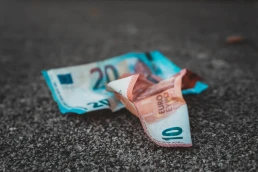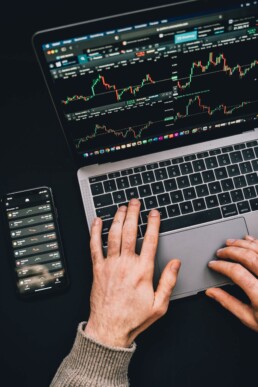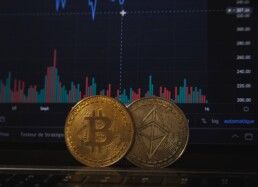Renting or buying a house?
Renting or buying? Buying or renting?
And is renting really a complete waste of money?
In fact, the question that many are asking is "why pay the rent to the homeowner if I can pay for my home directly?"
To answer this question we must start from the beginning of the question and analyze the situation one piece at a time. And the only thing that makes sense is to analyze the problem over the long term.
First of all, renting a house is not throwing money into the fireplace, but it means having the use of an asset, in this case a house or an apartment. you are paying for the use of space that has no value to you in the future. This concept is basic, the value in the future is the key.
When you buy a house, and in almost all cases you are buying it making debt with a mortgage, you are borrowing money instead of a property and therefore you will pay the debt first, and then the interest for the use of this liquidity.
It should always be remembered that the money you borrowed today is used to buy an asset that will hopefully increase in value tomorrow.
It should also be considered that when the bank makes you a loan, you do not always have all the necessary money for the lend since not all banks provide 100% loans. So you will need to have a place to live for this period.
Another point to be sure of is what is expected in the short term. If you work in a company that sends you around the world, does it make sense to buy a house? If you change jobs and cities often, does it make sense to buy a house?
Being the owner of a house when you decide to take root and create a family is beautiful, but all the expenses that a property entails must be considered, therefore ownership taxes, purchase taxes, writing taxes, possible breakages of part of the house, checks to do at home, management fees and services without having to talk about house bills.
Those who are renting, on the other hand, have only the cost of the rent, insurance, various expenses and bills. And a much easier chance to move if the area gets worse or coexistence with neighbors becomes impossible.
Remember that needs and requirements change over the years, especially if the family grows with one or two children. Buying a house for two people and then having to live there in 4 is not easy but living there 35 or 40 years is certainly more economically viable than living in rent for the same time, especially because after 40 years you will be the owner of a property that will have a value.
But think about how many things can change or go wrong in 40 years, think about the divorce rate in your country.
The issue is difficult to tackle on a general level since each of us has different ideas, ways of life and expectations of the future. The real estate market is a market that must be studied and understood like any market and which is subject to price fluctuations. Many personal factors need to be considered before making the final decision.
Buying a house is simple, much more difficult is having to sell it. Always without falling into the debt trap
Diversification
Today we will understand how diversification works.
Diversification is an investment strategy to lower the risk factor on the markets and the global economy. You must always remember that the stocks or bonds you buy on the market are issued by companies that work, produce, take risks and make mistakes.
Only those who do nothing are never wrong o never make mistakes.
These risks and errors can be of various kinds, from the administrative level to company management or they can change situations or laws that outline the correct policies regarding companies in a given territory. Many of these issues are visible with a long-term view, but very often it happens that problems suddenly fall out of the sky.
So a common sense strategy might be not to put all your eggs in one basket, but to have your money invested in various companies, so that an attack on one company doesn't cause you to lose all your money.
This is to reduce the risk of the portfolio.
This kind of strategy works best only when your asset position arent correlated, that it means that a financial asset is affected to rise or fall in price, due to the rise or rise in the price of another financial asset. To take an example, think of the value of gold and the value of mining shares, or of oil and the shares of oil companies.
If you want to understand if your investments are uncorrelated, look for some tools on the internet that can help you.
A good general way to diversify is to invest in different industries in different sectors.
Given that each sector encounters different and unique risks. The same goes for when we think about different countries or continent. Different countries have different risks and problems
Globalization has helped us with the possibility of investing our money in different countries of the world, but this has meant that the correlation between the various companies even from different continents increased, just think of how Western companies are only linked to the supply of raw materials and semi-finished products from Asia.
Diversifying is not a quick and easy strategy, quite the opposite. We need to spend a lot of time studying the various issues and then studying the various companies that may interest us. Creating a risk-free portfolio is nearly impossible but doable.
We will then have to be careful about the costs of creating the portfolio given the amount of positions we could open.
ETFs are a good choice, but that's your job. Study and choose the best for you and your family's financial life. Remember not to run into a false diversification by buying different assets but which then have the same underlying.
Always remember that your goal is to safeguard the account, avoid large drops in its value and limit volatility by controlling risk.
Dividends
Today let's talk about what dividends are and why we like them so much.
Dividends are funds, money, that companies give to those who own their shares. Generally speaking, we do not talk about very large figures per share, but having so many shares the figure begins to be interesting.
In fact, owning this kind of shares leads to having extra cash flow in our account. A gain is not only made by buying and selling the shares but also by owning these dividend-paying shares.
Now, the first thought that comes to mind is that a stock portfolio can only be made up of dividend-paying stocks, but you have to be very careful. In fact, it is a good strategy but it has inherent problems.
Theoretically, companies pay dividends when they think they cannot increase their earnings by reinvesting in the company. Very often dividends are used as a tool in the hands of companies to remunerate part of the management and part of the corporate stakeholders.
This is why dividends are paid more easily by companies that have been on the market for some time and not by new companies that need to reinvest in themselves or that do not even have this liquidity.
The corporate sector also plays a role in paying dividends. some sectors are more inclined like the energy and oil sector, where only it is easier to create long-term contracts with sovereign states, with large and certain cash flows. These are stable operations in a "slow" market.
The companies of the new economy instead work in a very fast market, much more fluid and with big technological changes that does not lend itself.
Dividends can be a great solution for income investors, like those who invest to get money into their portfolio.
The risk management of dividend stocks is slightly different from others. In fact, one is led to think that companies that give dividends are more disciplined, giving a sense of security to the investor. In this way, the investor himself has a management that can be simplified having a certain annual return.
One of the possible strategies with dividends is to reinvest buying other stocks that will pay more dividends and so on for years to come.
It must be said that having a dividend-only portfolio is an interesting idea, but we must also understand that to have interesting figures we will have to immobilize an important figure on the stock market, which is notoriously risky and volatile. Stocks can crash and companies can make mistakes that can lead them to eliminate dividends. Unfortunately, the market does not appreciate this move and that company's stock could suffer a further collapse.
Dividend stocks are attractive but should not be abused.
Long or Short
This is a short article that will explain some of the terms that you can find in the world of trading.
Learn more about exchange here and here.
You will often hear from people in the environment talking about being Long or being Short
This is the result of a diametrically opposite view of the market by the trader.
Being Long means having purchased the financial instrument.
Being short means having borrowed the financial instrument.
In fact, in the world of trading we can not only buy an asset, assume a share or a cryptocoin, but also borrow it. It all depends on how we consider the future trend of this action, like the rise or fall of the price.
The market can be defined as bullish or bearish, in the event that it is increasing in value or losing value. There are two animals that describe the uptrend or the downtrend
The bull is the uptrend market. In fact, it is defined as the bull market. The bull strikes from the bottom up.
The bear is the downtrend market. Hence Bear Market, as the bear strikes from top to bottom.
Long means being the owner of the asset. Our hypothesis is that the market is bull so the asset's value will go up so we will wait for the value to rise to sell it at a higher price
Being short means that we think the value of an asset will go down, we will be in a bear market, so we are going to borrow the asset from a lender. We will sell our asset at € 5, it will drop to € 3 and we will buy it back at this amount so as to give it back to the previous lender. The 2 euro difference is your earnings
Always check your broker's costs regarding being short, they must be carefully monitored to manage them in the best possible way.
How negative interests works
Today we explore the topic of interest rates, and we will see what negative interest rates are and how they operate.
What is a negative interest rate?
A negative interest rate is a loan, granted by a financial entity, where you do not pay to take money but you are paid to access this loan.
A debtor who is paid to take a debt.
Fantastic.
BUT What do negative interests on the economy really mean?
Interest is the amount that you pay to the bank to borrow money for your business or family activities, or it is the money that is credited to you by the bank to hold your funds in your bank account.
The low rates are created to push banks to increase lending and not keep a lot of liquidity stored in their accounts, flirting with customers that need to access these low-cost loans.
High interest rates are used to push people to spend less and try to keep inflation under control by cooling the economy.
The opposite is created by lowering rates.
The ECB European Central Bank started with negative rates in 2014 while the central bank of japan started in 2016
With negative rates, banks will begin to lose profit from the money deposited in their customers' accounts.
Negative interest also means that deposit accounts and money held on checking accounts will be paid at zero or you will have to pay to keep yopur accounts in the bank. In this case the bank could decide to absorb this cost from their customer if they take other products of the bank such as insurance, mortgages, etc.
It happened in denmark that a bank applied a rate of -0.5%
Consumers are so discouraged from keeping cash in their checking accounts and are therefore pushed to spend. This affects the entire economic chain, both private and corporate.
The costs for loans to the public will certainly be higher than those that the bank will have, after all it is their business
In the case of negative interest decided by the central bank, consumers do not necessarily have to have negative interest on their loans as well.
At the moment, we do not fully understand the real consequences of negative interests on the real economy, despite the fact that these seem an excellent thing to the man in the street.
Theoretically, low or even negative rates serve to push the economy with greater consumer spending, a greater propensity to borrow and a growth in consumption and therefore a growth in inflation.
With inflation, or the growth of consumer prices, there is a loss in value of the currency of the country that is the victim,
which means a greater possibility of selling their products abroad given their lower value at the exchange rate with competitors, another boost to the demand for goods and services.
All good, if it happens.
The countries that are now protagonists of this financial policy based on negative rates have had problems with chronic slow growth and are therefore in deflation.
Deflation encourages banks and people not to spend their money.
Deflation leads to the cycle more saving less spending. negative interests are seen as a method to discourage this cycle and indeed reverse it
Negative interests can have many negative effects on the economy and the population. People may decide to own their savings in physical currency, creating a run at ATM instead of keeping their cash in bank accounts and then paying the banks fee.
Financial bubbles are another effect, people could borrow to an unsustainable level and then create a financial bubble, with all that goes with it. Do you remember our toxic assets?
Which means making risky investments with money that savers cannot afford to lose. In the event of a crash the situation would be really problematic.
Negative interest then affects savers and bond investors. Savings are no longer remunerated and bond yields go to 0,
the risk is no longer correctly remunerated, creating market distortions, which leads to an increase in the risk in the investment portfolio to maintain the same level of remuneration.
Think about how all pension funds and bond funds are affected
Companies take debt money not to create new production lines or increase their workforce, but to buy back their shares, artificially increasing their value on the market
Banks are also affected, as this action greatly lowers their profits on loans and other products.
Negative rates can be seen as paradoxical and controversial
Negative rates on various bonds lead to not placing the bonds on the market, since in a normal market no one lends their money without having an economic return.
On the contrary, we must mention the Safe haven bonds have a low if not non-existent yield, but we are talking about bonds issued by countries considered “safe” and “unshakable”.
Shadow Banking
Today we are going to learn what is the Shadow Banking,
While the name may sound like something secret or illegal, this is just a parallel system to the traditional banking system for lending to individuals and businesses. Nothing illegal
Let's take an example to simplify the general explanation and understand how this system works, and probably you have used it without even thinking about it or knowing it. We use simple and easy numbers, purely for explanatory purposes.
Luca needs a loan to renovate his house, he goes to his bank and asks for an amount X. Luca is a good payer and therefore the bank would grant him the loan at a rate of 5% per year
However, Luca is not satisfied and remembers that a colleague suggested the CCX Finance. CCX deals with loans for real estate, cars, university and more.
Luca shows up in one of the CCX offices and the same loan for the same amount X would have a rate of 3.5%.
Luca as a customer does not find differences in the two loans, his only interest is in having the amount X he needs at the lowest available cost in the same agreed period of time.
So Luca for his convenience chooses to make a contract with the CCX
Here is an example of shadow banking.
The problem with shadow banking is how it is done or created. The banking circuit is created by people who save, and this savings goes into their current bank accounts. these current accounts are remunerated at 1%
the banks take this money, in customer accounts, and lend it to people like luca, at a rate of 5%. The difference between account yield and loan rate is the bank's business
CCX, on the other hand, having 200 Luca accessing his loan service, transforms the series of loans made to its customers into a derivative financial product.
Inside there will be loans whose risk will vary, as people will be different and with a different financial history, from the safest to the most risky.
Obviously the greater risk will be more rewarded by customers with a worse financial history
This financial instrument will then be bought by someone, in this case from a pension fund, as its return on the market makes it extremely attractive.
the currency of the purchase of the instrument will enter into CCX, which will thus be able to create other loans to others Luca, loans which will be transformed into derivatives and sold to other funds and so on without stopping
As far as banks are concerned, there are strict regulations, especially after the 2008 crash. These regulations serve as a safety net for the banks and consequently for its customers.
Let's talk about capitalization and specific rules to save your deposited money
In companies like CCX, on the other hand, there is no safety net or if there is, it is very thin given the low or almost no regulation
Over the various years, the percentage of loans disbursed by banks in relation to loans disbursed by shadow banking has increasingly been in favor of the latter.
The main risk arises in the creation of the derivative financial assets that have the debts inside. The economic situation could change to a worse one, These debts could become bad debt and therefore waste paper. The problem would spill over to those who are the holders of the derivative securities, which could go to a value equal to zero and therefore cause the funds that hold them to fail.
On the other side of the fence, in the event of a lack of financial stability, the funds interested in purchasing these derivatives could be scarce, putting companies like CCX in difficulty and causing their customers to return to the banking world for liquidity. necessary.
Bitcoin Lightning Network
Lightning Network is one of the solutions for one of the problems of bitcoin.
Lightning Network is a system created on top of the Bitcoin blockchain, with specific rules, to have fast and fee-free transactions.
We all know Bitcoin is cool but it's not perfect. Bitcoin has limitations such as the speed and cost of transactions.
In a particularly dense period of transactions, not high enough fees and blocks every 10 minutes, can make your purchase or move from one wallet to another really slow and expensive.
Lightining network should solve all these problems. The concept of this system has been developed since 2015 and we have to imagine that it works as if it were a layer cake.
On layer 1 we have Bitcoin with the blockchain while on layer 2 we have the lightning network system.
This feature is created specifically for micropayments, so that all micro transactions are not written on the bitcoin blockchain. At least not immediately.
The payment channels are created so if I want to send funds to a friend of mine or to a shopkeeper we can open a payment channel between the two of us, with our payments not involving the main blockchain. the transaction will take place at the speed with which the two wallets are able to communicate with each other.
When the transactions between the two wallets are complete, a main transaction will be created and written to the main Blockchain.
Now, if we thought of a series of regular, small-scale transactions, such as coffee at the bar every morning, each transaction sent to the main bitcoin blockchain would cost us more in lost time and fees than the transaction itself. Does it make sense to spend 10 dollars of coffee and 20 on commissions?
NO
Now let's imagine opening a payment channel for my entire CY Mood team with my favorite bartender. Upon opening the payment channel, both parties deposit a certain amount of money to guarantee the total transactions. If I know my team drinks 100 coffees a week I will deposit an equal or greater amount.
On the main Bitcoin BlockChain there will be only 2 transactions, namely the first transaction to open the payment channel and deposit the coin and a second to "close" or complete the payment
Now if we go back to our second layer, thousands millions of transactions can take place within the payment channel without these being written to the main blockchain. My team will be able to drink thousands of coffees and every time they buy, they will write an X BTC transaction to the barista
Weekly, monthly or every time my barista friend wants to cash out the coffee bitcoins, he will decide to write the transaction on the main BlockChain.
The system works best for small repeating transactions, we can think of our baker or the barber. There is obviously a system against scams, for those who want to close the payment channel in advance and not pay anything. In this case, the total of the initial deposit would be sent to the scammer. This greatly discourages scams.
Another interesting ability of the Lightning network is the ability to make payments to people with whom we do not have an open channel, but using other people's channels.
Save your bitcoins - Security Rules
Safety first. With crypto, this is imperative.
Lets start from a very important premise. Bitcoin is currently considered a safe system.
The weak point in the use of bitcoin is the user.
the weak point is you.
But this big problem can be solved with careful planning and habits every time you use bitcoin.
Losing your bitcoins means losing access to the wallets where they are stored or sending them to people or exchanges from which we can no longer recover them. Another example of a loss could be considered the theft of the wallet by a criminal.
Always remember that there is no way to delete a transaction on the blockchain, and those Bitcoins sent cannot come back. There is no regulatory autorithy that will protect you from malicious people and get your bitcoins back. Is only your responsibility to protect yourself
But what are the steps to protect yourself.
First of all, a wallet must be created, and this wallet will have a private key. This private key must be keep secret and you must back it up
If you don't know what kind of wallet to open, check out our article on the various types of wallets.
To access this wallet, create a login password. Back up your login password.
Remember that you are not in control of wallets on exchanges, so do not forget funds on exchange unless you are trading. Exchanges are like banks, they own your money but control is in their hands.
For large quantities of bitcoins, it is imperative to use hardware wallets
Make a copy of the wallet's private key and password on a USB stick. Encrypt this key and hide it in a safe place. You can choose to have multiple keys with multiple passwords for the different wallets you are going to create. Obviously you don't have to forget the password otherwise you will lose everything.
Create one or more strong passwords,it means that you have to create password with at least 8 characters, better if there are more. With a mixture of lowercase and uppercase letters, numbers and special characters.
Do not use passwords from other accounts such as email.
A good idea for a password is a sentence made with one or more grammatical errors, or by substituting letters with numbers such as 5 instead of S
the best possible password, however, is a string of characters and numbers and random symbols but it is difficult if not impossible to remember
You can also use a password manager to generate and track passwords
Some hardware wallets require you to use Pin codes, always prefer 8-digit ones over 4-digit ones and don't use dates of birth.
When accessing exchanges, always try to use 2-factor authentication and not SMS. You can check out our 2-Factor Authentication video to learn more. SMS is not recommended because it could be intercepted by a hacker and used to defraud you or empty your wallet.
If you need to access an exchange or your wallet, it is absolutely not recommended to use a public wi fi. Wait until you have a secure line or use a VPN. Much better never to use public wifi.
You have to pay attention to the sites you use and check the emails that come to you. Phising sites and emails are a real threat.
check that you have a secure SSL connection via HTTPS. There are many scams with cloned sites and domains that look the same but that if carefully observed have very small discrepancies from the originals
Another precaution is not to click on the links within the unsecured emails. We can receive emails from the exchanges where we are registered but we must check carefully and if the email seems suspicious, throw it. Obviously never open attachments from these emails. Remember that an exchange email should contain your name, not just Sir or Dear Customer. Another test is to check the real origin of the email.
remember that transactions cannot be canceled or returned.
Precisely for this reason when you send money always check the sending address twice and never write the address manually,
because you will face always complicated address, and if you make a mistake and send money to an address that has nothing to do with it and you never get those coin back.
The security of your Bitcoins is entirely up to you.
Virgin BTC- A brand new Bitcoin...
Speaking of mining, you also need to know what virgin bitcoins are.
A virgin bitcoin is a bitcoin that has just been mined or that has never transacted on the blockchain or that has a certified transaction history.
In the world of cryptocurrencies, many scams have occurred against bitcoin users, while other bitcoins have been used for illegal activities, theft or money laundering.
Since the blockchain is visible to all, it is possible to track the history of every single bitcoin by checking its transaction history. Which is difficult but real.
The authorities of a country could keep an eye on some wallets with bitcoin inside involved in criminal actions. In this case, if these were passed on the wallet of some exchange, they could be blocked or not accepted by the exchange.
This can create concerns and some financial intermediaries may not accept bitcoins of non-certified origin.
And here a Bitcoin without transactions is very useful and therefore its price will be higher than a normal bitcoin, in the order of 20 or 30 percent more.
The increased regulatory push drives the demand for virgin bitcoins.
Bitcoins without a clean history are not to be considered dirty or unused but we simply don't know what their life was like before we had them in our wallet. Life that may have been extremely adventurous
Blockchain protocols: investors point of view
In previous articles we have seen that there are different types of coins and therefore there are different ways to create them, or rather, to mine these coins. Learn more about mining here.
With different protocols for creating coins, from the investor's point of view we have another feature to be studied before making any purchase.
In fact, cryptocurrencies investors must analyze the blockchain protocol before investing in coins. Consensus algorithms can be the key to success with effects on inflation rates, security and the total value of the currency. Learn what is a Blockchain here.
But what is a Blockchain protocol?
A blockchain protocol is the common term for defining consensus methods.
Consensus methods are different systems created to reach consensus and validate transactions in a blockchain network.
Some require miners to hold coins, others require hardware to mine such as computers or graphics cards.
We know there are 3 types of consent which are:
Proof of work, proof of stake and delegated proof of stake
Let's briefly see some details:
Proof of work: from energy to value
Bitcoin and other coins use Proof of Work (PoW) as a consensus algorithm.
In the PoW consensus type, miners participate in the network by adding large amounts of computing power.
Big miners create physical mining rigs, consisting of several graphics cards in series, if not hundreds.
More powerful platforms equate to more chances of closing the next block and receiving the next block's reward coins.
Blockchain Transactions also include transaction fees.
So, in this case, the miner has to buy a large number of expensive graphics cards, spending a lot of money before earning a single bitcoin (or any other currency).
Miners can create a mining pool to combine their computing power and add more chances of receiving rewards.
In the proof of work economy Miners must spend thousands of dollars to build computer technology plants and pay high electricity bills to participate in networks of this type of blockchain otherwise, there would be no currency and no blockchain
In theory, these costs should add great value to a PoW coin
Miners don't want to sell coins below their mining cost
If you want to find out the minimum cost of a coin of this type, you need to look:
- The cost for miners to mine new coins (rig + electricity)
- The time to create a block and its reward
Let's take an example. If we have a PoW scheme with:
- Quick block creation times
- High reward
- Low total amount of money offered
Then the total supply will reach its maximum rapidly. As long as the demand for money is high, the currency should perform well. Otherwise you can see how the market reacts and wait until all the coins are created.
In another PoW scheme we have:
- Slow block creation times
- Low reward for blocks created
- high total money supply
In this example, the inflation rate is low due to lower demand. The coin will be profitable as long as it is new and scarce on the market.
Proof-of-Stake: no more platforms and computers
Proof of Stake or PoS does not require the purchase of mining rigs or the payment of huge electricity bills
The POS is a very different consensus model that allows all coin holders to contribute to the network and block building
You have to keep the coins in your wallet, activate staking and leave your computer on and you will receive rewards by acting as a miner
In this way, the Pos is a great incentive to hold coins also because the more coins you have, the more you contribute to the network and the more you have the chance to solve the next block.
So, in this case, miners have to spend a lot of money to buy coins to stake.
This is much simpler and faster than the proof of work protocol
The only available metrics are total supply, current supply, inflation rate, and current market price. So, you can analyze this market in a similar way to a fiat currency by measuring supply and demand.
DPOS Delegate proof of Stake with reliable nodes
This is a variation of the classic POS.
In this protocol, all coin holders elect delegates.
These delegates are the only ones authorized to verify and add new blocks to the blockchain.
In this case we can have a centralization of the first users with many coins. By the way, delegates need to be voted on by the community, so a good reputation and participation in the coin community is needed.
Lisk as an example has a Dpos consensus scheme.
As we said earlier for the consensus on the POS, if you want to be a miner you have to buy a lot of coins, but unlike the POS, in this case you have to trust the community. And you can't buy or sell trust.
There is no perfect system, but these 3 systems can solve the inherent control problems of a decentralized currency. It should also be noted that you have to consider the environmental problem of energy consumption among various factors.












